Drobo 5D with BeyondRAID - Protected Direct-Attached Storage Made Simple
by Ganesh T S on April 25, 2016 8:00 AM EST- Posted in
- Storage
- USB 3.0
- DAS
- Drobo
- BeyondRAID
Direct-Attached Storage Performance
Evaluation of DAS units on Windows is done with the testbed outlined in the table below. We had started evaluation with the older Haswell-based testbed, since it has Thunderbolt 2 support. Eventually, we learnt during the course of evaluation that the Drobo 5D's Thunderbolt ports are useless when the unit is used with PCs / Windows. Despite this, we continued and completed our evaluation using the USB 3.0 interface on the same testbed. We utilize the USB 3.0 port directly from the Z97 PCH.
| AnandTech DAS Testbed Configuration | |
| Motherboard | Asus Z97-PRO Wi-Fi ac ATX |
| CPU | Intel Core i7-4790 |
| Memory | Corsair Vengeance Pro CMY32GX3M4A2133C11 32 GB (4x 8GB) DDR3-2133 @ 11-11-11-27 |
| OS Drive | Seagate 600 Pro 400 GB |
| SATA Devices | Asus BW-16D1HT 16x Blu-ray Write (w/ M-Disc Support) |
| Add-on Card | Asus Thunderbolt EX II |
| Chassis | Corsair Air 540 |
| PSU | Corsair AX760i 760 W |
| OS | Windows 10 Pro x64 |
| Thanks to Asus and Corsair for the build components | |
The full details of the reasoning behind choosing the above build components can be found here. The list of Drobo 5D configurations used for comparison purposes is provided below.
- Drobo 5D SDR Yes mSATA (Single disk redundancy with mSATA acceleration)
- Drobo 5D SDR No mSATA (Single disk redundancy without mSATA acceleration)
- Drobo 5D DDR Yes mSATA (Dual disk redundancy with mSATA acceleration)
- Drobo 5D DDR No mSATA (Dual disk redundancy without mSATA acceleration)
Synthetic Benchmarks - ATTO and Crystal DiskMark
The Drobo 5D delivers best-case numbers of close to 300 MBps writes and 250 MBps reads in the single-disk / mSATA inactive configuration for our standard ATTO benchmarking configuration. Obviously, the benefits of mSATA acceleration don't come out in this quick-and-dirty benchmark. However, we can see that dual-disk redundancy solutions fare a little worse compared to the single-disk redundancy solutions.In any case, these access traces are not very common in real-life scenarios.
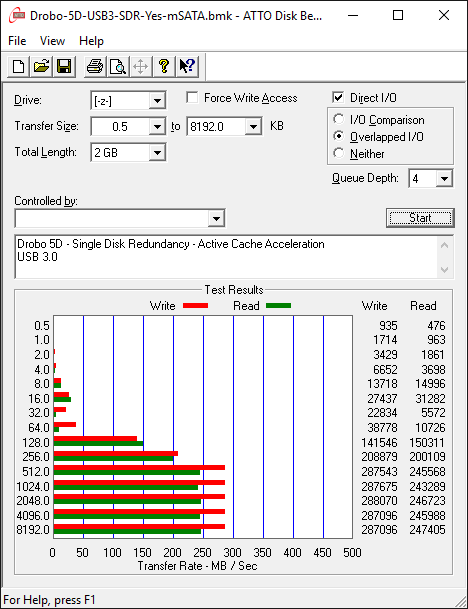
CrystalDiskMark, despite being a canned benchmark, provides a better estimate of the performance range with a selected set of numbers. In this case, we can see the sequential access numbers back up the ATTO results. Random access numbers are quite decent for a hard-drive array.
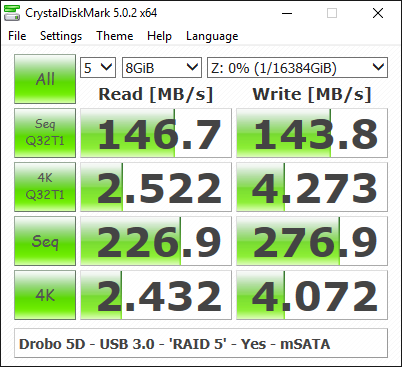
Benchmarks - robocopy and PCMark 8 Storage Bench
Our testing methodology for DAS units also takes into consideration the usual use-case for such devices. The most common usage scenario is transfer of large amounts of photos and videos to and from the unit. Devices like the Drobo 5D are often used to import files directly off the DAS into a multimedia editing program such as Adobe Photoshop.
In order to tackle the first use-case, we created three test folders with the following characteristics:
- Photos: 15.6 GB collection of 4320 photos (RAW as well as JPEGs) in 61 sub-folders
- Videos: 16.1 GB collection of 244 videos (MP4 as well as MOVs) in 6 sub-folders
- BR: 10.7 GB Blu-ray folder structure of the IDT Benchmark Blu-ray (the same that we use in our robocopy tests for NAS systems)






In all the above benchmarks, we see that the mSATA cache acceleration is not useful at all (we are testing out a one-time copy of data to and from the unit). The single-disk redundancy configuration consistently performs better than the dual-disk redundancy option.
For the second use-case, we take advantage of PC Mark 8's storage bench. The storage workload involves games as well as multimedia editing applications. The command line version allows us to cherry-pick storage traces to run on a target drive. We chose the following traces.
- Adobe Photoshop (Light)
- Adobe Photoshop (Heavy)
- Adobe After Effects
- Adobe Illustrator
Usually, PC Mark 8 reports time to complete the trace, but the detailed log report has the read and write bandwidth figures which we present in our performance graphs. Note that the bandwidth number reported in the results don't involve idle time compression. Results might appear low, but that is part of the workload characteristic.


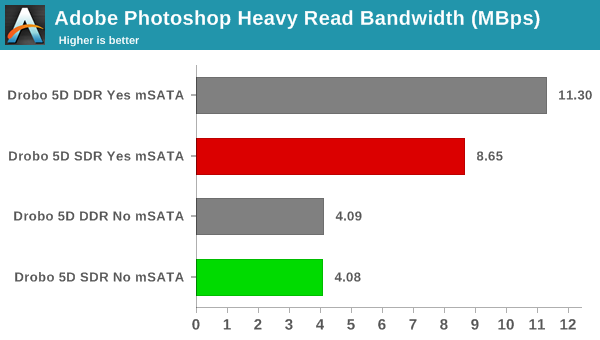

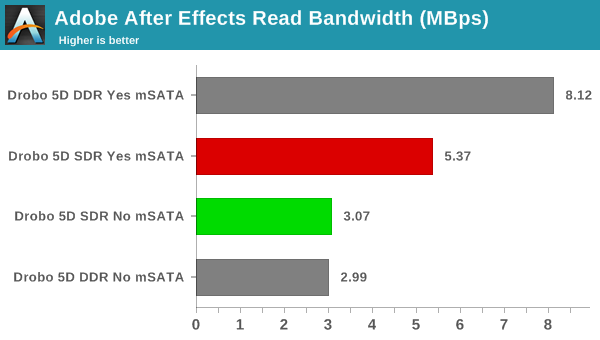

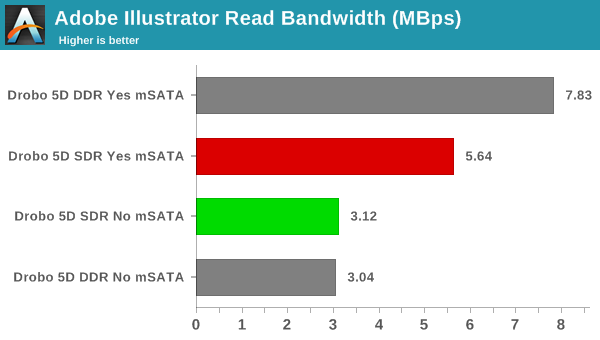

In the real-world work traces, we can see the real benefit of the mSATA SSD cache acceleration. Writes don't benefit much, but, in the read workloads, we can see that the mSATA SSD-enabled configurations often provide almost double the performance of a raw hard-drive array.










74 Comments
View All Comments
rrinker - Tuesday, April 26, 2016 - link
No, the lifecycle support for Server 2008 is until January 2020, security patches only. It's on that same lifecycle page. Security patches for 2012 R2 go until January 2023. If I'm still running this same hardware (already almost 6 years old) in another 7 years, it will be either a miracle or else I will have stuffed it in a closet and forgotten it's running. It's a first gen I3 I built in early 2010. I just retired a first gen I5 workstation that would actually make a better server (the mobo has 8 SATA ports - the I3 board only 6 so I have a dual port PCIe card) but that one dates from late 2009. Server 2016 is at Tech Preview 4 so I'll plan on new hardware and a new server next year.doggface - Tuesday, April 26, 2016 - link
Freenas. Literally costs nothing to implement.JeffFlanagan - Monday, April 25, 2016 - link
I use DrivePool too, with 5 Mediasonic ProBox USB3 drive bays, which makes swapping out failed drives easier than when they were in the PC. If you have to ditch Home Server, you can still use DrivePool on a desktop version of Windows.As you mention, DrivePool is safer than Raid. I had 2 drives fail at the same time, and only lost about 5% of my data. If I had set up DrivePool to keep 3 instances of every file, I would have had no data loss at all. On RAID, it would have been a total loss.
Ratman6161 - Monday, April 25, 2016 - link
Just an FYI: RAID is not a substitute for backup...it was never intended to be. With a good backup scheme, there is no reason why you should lose any data even with a single disk setup.but yes, for
Ratman6161 - Monday, April 25, 2016 - link
...someone willing to DIY it, one way or another there are cheaper ways to do this. But for the non-techie or less-techie who doesn't mind spending the money, this could be a good solution. There are also thunderbolt cards available for PC's .rrinker - Tuesday, April 26, 2016 - link
That's sort of the whole point of WHS - it's really for the non-techie. You don't have to build your own box for it, you can use off the shelf computers, and the whole thing is actually pretty dumbed down with a big dashboard control panel that shields you from the usual Windows Server management stuff. That was the whole point of the product - there were complete off the shelf solutions too so you wouldn't even have to install an OS, just plug it in and turn it on. Plug some more drives in to expand storage, size didn't matter. What's funny is most people I know that have DRobo or similar are those with rather high levels of technical skill, not the PC illiterate.owan - Monday, April 25, 2016 - link
WHS2011 w/ DrivePool by itself doesn't replicate the full functionality of a RAID setup. At best DrivePool can do RAID 1 type protection through file duplication. That leaves you with 50% storage efficiency. However, you can easily implement SnapRAID to do snapshot parity calculations on your drive pool w/ multiple drive redundancy (i.e. RAID 5/6 type protection). Its not real-time protection, but its good enough for me at the moment.kmmatney - Monday, April 25, 2016 - link
I'm also using WHS 2011 with Stablebits drivepool, for the same reasons you do. I have 7 hard drives of various sizes in my drive pool (bought a $25 SATA card to give me more ports). Besides automatic backups of 8 computers in my house, it is also a minecraft server, ftp server, media server, etc... I'm still wondering what my next move will be, but it will probably be a Windows 10 system, with Stablebit drive pool. Not sure what to do about autoamtic computer backups, but a program called "Ur Backup" that looks promising and is open source.voicequal - Monday, April 25, 2016 - link
I replaced my WHS 2011 with Server 2012 R2 Essentials running on the same hardware. It has the same client backup and bare metal restore capabilities as WHS2011. I didn't trust WHS2011 anymore given its low adoption and impending EoL, particularly for Win10 clients. Windows Storage Spaces provides drive pool functionality, but overall I found better performance in just mapping shares to different physical drives. I particularly recommend putting the Client Backups folder on its own physical drive, as disk response slows when a client is doing a backup. For server backups, I run Crash Plan on the server to do cloud backup of all the drives.I'm looking at an alternative solution for my parents, possibly a generic NAS with Macrium Reflect or Acronis True Image running on the clients. Bare metal restore has saved me too many times to rely on file/document backups alone.
rrinker - Monday, April 25, 2016 - link
I was amazed when I upgraded my primary machine from Win 7 to Win 10 and the WHS client just worked, same as it always has. There was an update for Win 8 which seems to have enabled operation with 10 as well, I already had the Win 8 update to the client installed on my server since my laptop had 8.1 before I installed the Win 10 update.